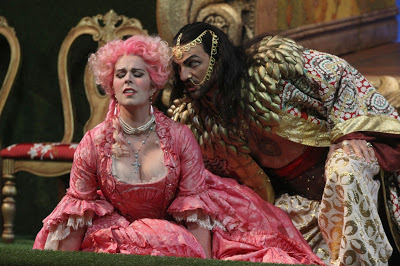The ‘why’ behind Seraglio and Mozart’s stew of Turks, sex and farce
 |
| Photo Credit: Michael Rollands |
By Noel Morris
Islam, kidnapping, sex, and slavery — these are risky
conversation topics for holiday gatherings. But not in 1782. Mozart’s The
Abduction From the Seraglio places the action outside a Turkish
harem. It isn’t a probing exploration of religion or human rights, however, it’s
farce. Based on Belmont und Constanze by Christoph Friedrich Bretzner, the Turkish palace is but a backdrop
to the drama of two women, their lovers, and the powerful Muslim men who seek
the women’s affections. It’s worth considering why Mozart chose this story.
conversation topics for holiday gatherings. But not in 1782. Mozart’s The
Abduction From the Seraglio places the action outside a Turkish
harem. It isn’t a probing exploration of religion or human rights, however, it’s
farce. Based on Belmont und Constanze by Christoph Friedrich Bretzner, the Turkish palace is but a backdrop
to the drama of two women, their lovers, and the powerful Muslim men who seek
the women’s affections. It’s worth considering why Mozart chose this story.
For nearly 500 years, the Ottoman Empire had expanded its range,
conquering and plundering whole civilizations. Twice, Turkish forces attempted
(and failed) to take Vienna — the second siege lasted two months and ended in
September 1683. Mozart’s father would have known people who lived through it.
conquering and plundering whole civilizations. Twice, Turkish forces attempted
(and failed) to take Vienna — the second siege lasted two months and ended in
September 1683. Mozart’s father would have known people who lived through it.
Even as European slavers were shipping Africans to the Americas,
North African pirates were selling Europeans to the Turks. Mozart knew of
charities that paid ransoms to bring people home.
North African pirates were selling Europeans to the Turks. Mozart knew of
charities that paid ransoms to bring people home.
One might expect Mozart’s Vienna, then, to despise the empire
to the south — but no—all things Turkish were in vogue. Tales of European
ladies serving as sex slaves in exotic lands became popular fiction. People
commissioned portraits of themselves clothed in fabrics from Istanbul. And
merchants opened establishments serving a beverage called coffee. (Legend has
it that the Viennese coffee craze began after the siege of 1683 when the
fleeing army left behind bags of strange-smelling beans.) Mozart’s nod to Turquerie offers a lovesick Pasha and an
extraordinary act of mercy.
to the south — but no—all things Turkish were in vogue. Tales of European
ladies serving as sex slaves in exotic lands became popular fiction. People
commissioned portraits of themselves clothed in fabrics from Istanbul. And
merchants opened establishments serving a beverage called coffee. (Legend has
it that the Viennese coffee craze began after the siege of 1683 when the
fleeing army left behind bags of strange-smelling beans.) Mozart’s nod to Turquerie offers a lovesick Pasha and an
extraordinary act of mercy.
Ears in the 21st century might strain to hear exotic sounds in
Mozart’s score. In 1782, the Viennese recognized echoes of the Ottoman Empire.
The bass drum and the jingling of cymbals, triangles and piccolos conjured the
military bands that had terrorized their city in 1683. In Abduction,
they spin a musical costume around Turkish characters.
Mozart’s score. In 1782, the Viennese recognized echoes of the Ottoman Empire.
The bass drum and the jingling of cymbals, triangles and piccolos conjured the
military bands that had terrorized their city in 1683. In Abduction,
they spin a musical costume around Turkish characters.
Turning travel
into music
into music
Composing The Abduction came at a major intersection in
Mozart’s life. At 25, the former child prodigy had just left home for good.
Mozart’s life. At 25, the former child prodigy had just left home for good.
His father, Leopold, was a stage parent. A respected musician, he
cultivated his son’s genius from an early age and touted him in courts across
Europe. British scholar Daines Barrington presented an eyewitness account of
meeting with the 8-year-old Wolfgang in 1764. Barrington selected a complex
score in five parts and presented it to the boy seated at the harpsichord.
Barrington wrote:
cultivated his son’s genius from an early age and touted him in courts across
Europe. British scholar Daines Barrington presented an eyewitness account of
meeting with the 8-year-old Wolfgang in 1764. Barrington selected a complex
score in five parts and presented it to the boy seated at the harpsichord.
Barrington wrote:
“The
score was no sooner put upon his desk, than he began to play the symphony in a
most masterly manner, as well as in the time and style which corresponded with
the intention of the composer.”
score was no sooner put upon his desk, than he began to play the symphony in a
most masterly manner, as well as in the time and style which corresponded with
the intention of the composer.”
Barrington’s account reveals something elemental about Mozart: He
could instantly comprehend and master new musical styles. From his travels, he
absorbed everything from Italian opera to the sacred music of J.S. Bach. As we
see in The Abduction From the Seraglio and the operas to come, he throws
that experience into his scores, giving opposing characters opposing musical
styles.
could instantly comprehend and master new musical styles. From his travels, he
absorbed everything from Italian opera to the sacred music of J.S. Bach. As we
see in The Abduction From the Seraglio and the operas to come, he throws
that experience into his scores, giving opposing characters opposing musical
styles.
Although Mozart remained deeply devoted to his father, he defied
him twice in the year or so surrounding this opera’s composition. In
1773, Leopold had procured for Wolfgang a position in the court of his own
employer, the Archbishop of Salzburg. While Leopold knew his place in the
world, Wolfgang resented it. As a low-ranking servant, Mozart suffered many
humiliations at the hands of his boss. By spring 1781, he begged for release. He
succeeded in June, getting himself booted out of Salzburg — literally “with a
kick in the arse.” He left for Vienna, seeking fame and fortune.
him twice in the year or so surrounding this opera’s composition. In
1773, Leopold had procured for Wolfgang a position in the court of his own
employer, the Archbishop of Salzburg. While Leopold knew his place in the
world, Wolfgang resented it. As a low-ranking servant, Mozart suffered many
humiliations at the hands of his boss. By spring 1781, he begged for release. He
succeeded in June, getting himself booted out of Salzburg — literally “with a
kick in the arse.” He left for Vienna, seeking fame and fortune.
Creating a
‘singspiel’
‘singspiel’
By July, Mozart had secured a commission for an opera. Vienna’s
Burgtheater, sponsored by Emperor Joseph II, offered him Bretzner’s libretto to
The Abduction From the Seraglio, reworked by Gottlieb Stephanie.
Burgtheater, sponsored by Emperor Joseph II, offered him Bretzner’s libretto to
The Abduction From the Seraglio, reworked by Gottlieb Stephanie.
The new opera was to be a “singspiel,” taken from the German
words singen (to sing) and spiel (play). Singspiel juxtaposes dialogue and
music, similar to the Broadway musical. Treating the job like an audition,
Mozart wrote to his father:
words singen (to sing) and spiel (play). Singspiel juxtaposes dialogue and
music, similar to the Broadway musical. Treating the job like an audition,
Mozart wrote to his father:
“As
we have given the part of Osmin to Herr Fischer, who certainly has an excellent
bass voice (in spite of the fact that the Archbishop told me that he sang too
low for a bass and that I assured him he would sing higher next time), we must
take advantage of it, particularly as he has the whole Viennese public on his
side. But in the original libretto Osmin has only this short song and nothing
else to sing.”
we have given the part of Osmin to Herr Fischer, who certainly has an excellent
bass voice (in spite of the fact that the Archbishop told me that he sang too
low for a bass and that I assured him he would sing higher next time), we must
take advantage of it, particularly as he has the whole Viennese public on his
side. But in the original libretto Osmin has only this short song and nothing
else to sing.”
Mozart changed the story to fit the singer. The Turkish overseer
became a major comic character: stupid, surly, malicious. And the music fits
the character, lacking the elegance and harmonic complexity of his European
captives — which is not to say it’s easier to sing. Osmin’s Act 3 aria “O, wie will ich triumphieren”
is famously difficult and showcases Fischer’s ability to sing a low D.
became a major comic character: stupid, surly, malicious. And the music fits
the character, lacking the elegance and harmonic complexity of his European
captives — which is not to say it’s easier to sing. Osmin’s Act 3 aria “O, wie will ich triumphieren”
is famously difficult and showcases Fischer’s ability to sing a low D.
While composing Abduction, Mozart ponders the conundrum of
writing beautiful music about anger.
writing beautiful music about anger.
“Passions,
whether violent or not, must never be expressed to the point of exciting
disgust, and as music, even in the most terrible situation, must never offend
the ear, but must please the listener.”
whether violent or not, must never be expressed to the point of exciting
disgust, and as music, even in the most terrible situation, must never offend
the ear, but must please the listener.”
Mozart’s solution is to give the singer more notes. When his
noble heroine Konstanze is confronted by a fate worse than death, she lets it
fly, singing a flurry of runs, trills and leaps. Her feisty servant, Blonde,
defies Osmin in similar virtuosic fashion, singing, “I am an Englishwoman, born for freedom.”
(It’s
interesting that Mozart’s egalitarian-minded servant is English, a safe
distance from Austria, given that he was composing at the command of the Austrian
Emperor).
noble heroine Konstanze is confronted by a fate worse than death, she lets it
fly, singing a flurry of runs, trills and leaps. Her feisty servant, Blonde,
defies Osmin in similar virtuosic fashion, singing, “I am an Englishwoman, born for freedom.”
(It’s
interesting that Mozart’s egalitarian-minded servant is English, a safe
distance from Austria, given that he was composing at the command of the Austrian
Emperor).
The Abduction From the Seraglio, which opened July 16, 1782, was a hit. Profits poured into the
Burgtheater, from which Mozart received a modest flat fee.
Burgtheater, from which Mozart received a modest flat fee.
Less than a month later Mozart defied his father once more and
married Constanza Weber. That he courted Constanza while creating the operatic
heroine Konstanze was purely coincidence; that he delighted in the irony was
pure Mozart.
married Constanza Weber. That he courted Constanza while creating the operatic
heroine Konstanze was purely coincidence; that he delighted in the irony was
pure Mozart.


